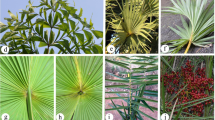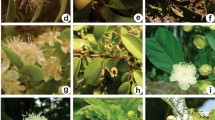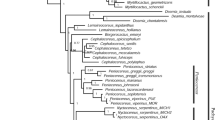Abstract
Phylogenetic studies were conducted for Carpinus and the subfamily Coryloideae (Betulaceae) using sequences of the chloroplast matK gene, the trnL-trnF region (trnL intron, and trnL [UAA] 3' exon-trnF [GAA] intergenic spacer) and the psbA-trnH intergenic spacer, and the nuclear ribosomal ITS regions. The combined analyses of the three chloroplast regions suggest that Coryloideae is monophyletic; Ostryopsis is sister to the Carpinus - Ostrya clade; Corylus is monophyletic and sister to the Ostrya - Carpinus - Ostryopsis clade; Ostrya is paraphyletic; and within Carpinus, species of sect. Carpinus from eastern Asia form a monophyletic group, whereas the positions of C. betulus from Europe and C. caroliniana from eastern North America are unresolved within the Carpinus clade. The cpDNA tree generated in this study is largely congruent with the previously published ITS results, but the ITS tree places Carpinus sect. Distegocarpus as sister to the Ostrya - Carpinus sect. Carpinus clade. Future work is needed to examine the relationships within the Ostrya - Carpinus clade, evaluate the generic status of Ostrya, and test the phylogenetic position of Ostryopsis.
Similar content being viewed by others
References
Abbe E. C. (1974). Flowers and inflorescences of the Amentiferae. Bot. Rev. 40: 159–261
Bousquet J., Strauss S. H. and Li P. (1992). Complete congruence between morphological and rbc L-based molecular phylogenies in Birches and related species (Betulaceae). Molec. Biol. Evol. 9: 1076–1088
Chen Z.-D. (1994) Phylogeny and phytogeography of the Betulaceae. Acta Phytotax. Sin. 32: 1–31, 101–153.
Chen Z.-D., Manchester S. R. and Sun H. Y. (1999). Phylogeny and evolution of the Betulaceae as inferred from DNA sequences, morphology, and paleobotany. Amer. J. Bot. 86: 1168–1181
Chen Z.-D. and Zhang Z.-Y. (1991). A study on foliar epidermis in Betulaceae. Acta Phytotax. Sin. 29: 156–163
Crane P. R. (1989). Early fossil history and evolution of the Betulaceae. In: Crane, P. R. and Blackmore, S. (eds) Evolution, systematics and fossil history of the Hamamelidae, vol. 2. Systematics Association Special Volume 40B, pp 87–116. Clarendon Press, Oxford
Cronquist A. (1981). An integrated system of classification of flowering plants. Columbia University Press, London
Dahlgren R. (1983). General aspects of angiosperm evolution and macrosystematics. Nord. J. Bot. 3: 119–149
Doyle J. J. and Doyle J. L. (1987). A rapid DNA isolation procedure for small quantities of fresh leaf tissue. Phytochem. Bull. 19: 11–15
Farris J. S., Källersjö M., Kluge A. G. and Bult C. (1995). Testing significance of incongruence. Cladistics 10: 315–319
Forest F. and Bruneau A. (2000). Phylogenetic analysis, organization and molecular evolution of the nontranscribed spacer of 5S ribosomal RNA genes in Corylus (Betulaceae). Int. J. Pl. Sci. 161: 793–806
Forest F., Savolainen V., Chase M. W., Lupia R., Bruneau A. and Crane P. R. (2005). Teasing apart molecular- versus fossil-based error estimates when dating phylogenetic trees: A case study in the Birch family (Betulaceae). Syst. Bot. 30: 118–133
Hall J. W. (1952). The comparative anatomy and phylogeny of the Betulaceae. Bot. Gaz. 113: 235–270
Hamilton M. B. (1999). Four primer pairs for the amplification of chloroplast intergenic regions with intraspecific variation. Molec. Ecol. 8: 521–522
Heywood V. H. (1993). Flowering plants of the world. BT Batsford Ltd, London
Hjelmqvist H. (1948). Studies on the floral morphology and phylogeny of Amentiferae. Bot. Not., Suppl. 2: 1–171
Hoar C. S. (1916). The anatomy and phylogenetic position of the Betulaceae. Amer. J. Bot. 3: 415–435
Hu H. H. (1964). The materials on the monography of genus Carpinus L. of China. Acta Phytotax. Sin. 9: 281–298
Huelsenbeck J. P. and Ronquist F. (2001). MrBayes. Bayesian inference of phylogeny. Bioinformatics 17: 754–755
Hutchinson J. (1926). Families of flowering plants, Dicotyledons, 1st ed. Macmillan, London
Hutchinson J. (1967). The genera of flowering plants, vol. 2. Clarendon Press, Oxford
Johnson L. A. and Soltis D. E. (1994). MatK DNA sequences and phylogenetic reconstruction in Saxifragaceae s. str. Syst. Biol. 19: 143–156
Kato H., Oginuma K., Gu Z., Hammel B. and Tobe H. (1998). Phylogenetic relationships of Betulaceae based on matK sequences with particular reference to the position of Ostryopsis. Acta Phytotax. Geobot. 49: 89–97
Kuprianova L. A. (1963). On a hitherto undescribed family belonging to the Amentiferae. Taxon 12: 12–13
Li P. C. and Cheng S. X. (1979). Betulaceae. In: Kuang, K. Z. and Lee, P. C. (eds) Flora Reipublicae Popularis Sinicae, vol. 21, pp 44–137. Science Press, Beijing
Li P. C., Skvortsov A. K. (1999) Betulaceae. In: Wu C.-Y., Raven P. H. (eds.) Flora of China, vol. 4. Science Press, Beijing, and Missouri Botanical Garden Press, Missouri, pp. 284–313.
Mabberley D. J. (1997). The plant book. 2nd ed. Cambridge University Press, Cambridge
Manchester S. R. and Chen Z.-D. (1998). A new genus of Coryloideae (Betulaceae) from the Paleocene of North America. Int. J. Pl. Sci. 159: 522–532
Manchester S. R. and Crane P. R. (1987). A new genus of Betulaceae from the Oligocene of western North America. Bot. Gaz. 148: 263–273
Mau B. and Newton M. (1999). Bayesian phylogenetic inference via Markov chain Monte Carlo methods. Biometrics 55: 1–12
Metcalfe C. R. and Chalk L. (1950). Anatomy of the dicotyledons, vol. 2. Clarendon Press, Oxford
Nakai T. (1915). Flora Sylvatica Koreana, vol. 2. Chosen Government Press, Seoul
Pigg K. B., Manchester S. R. and Wehr W. C. (2003). Corylus, Carpinus, and Palaeocarpinus (Betulaceae) from the middle Eocene Klondike Mountain and Allenby Formations of northwestern North America. Int. J. Pl. Sci. 164: 807–822
Posada D. and Crandall K. A. (1998). MODELTEST: testing the model of DNA substitution. Bioinformatics 14: 817–818
Prantl K. (1894). Betulaceae. In: Engler, A. and Prantl, K. (eds) Die natürlichen Pflanzenfamilien, vol. 3, pp 38–46. Engelmann, Leipzig
Rannala B. and Yang Z. H. (1996). Probability distribution of molecular evolutionary trees: a new method of phylogenetic inference. J. Molec. Evol. 43: 304–311
Rehder A. (1960). Manual of cultivated trees and shrubs hardy in North America. 2nd ed. The Macmillan Company, New York
Shimodaira H. and Hasegawa M. (1999). Multiple comparisons of log-likelihoods with applications to phylogenetic inference. Molec. Biol. Evol. 16: 1114–1116
Siebold P. F., de, Zuccarini J. G. (1846) Florae Japonicae familae naturales: adjectis generum et specierum exemplis selectis. Abhandlungen der mathematisch-physikalischen Classe der Königlich Bayerischen Akademie der Wissenschaften, Bd. 4, Abt. 2, 3.
Swofford D. L. (2003). PAUP*. Phylogenetic analysis using parsimony (*and other methods) Version 4.0 b10. Sinauer Associates, Sunderland, Massachusetts
Swofford D. L., Olsen G. J., Waddell P. J. and Hillis D. M. (1996). Phylogenetic inference. In: Hillis, D. M., Moritz, C., and Mable, B. K. (eds) Molecular systematics. 2nd ed. pp 407–514. Sinauer Associates, Sunderland, Massachusetts
Taberlet P., Gielly L., Pautou G. and Bouvet J. (1991). Universal primers for amplification of three non-coding regions of chloroplast DNA. Pl. Molec. Biol. 17: 1105–1109
Takhtajan A. (1997). Diversity and classification of flowering plants. Columbia University Press, New York
Templeton A. R. (1983). Phylogenetic inference from restriction endonuclease cleavage site maps with particular reference to the humans and apes. Evolution 37: 221–244
Thorne R. F. (1992). Classification and geography of the flowering plants. Bot. Rev. 58: 226–257
Whitcher I. N. and Wen J. (2001). Phylogeny and biogeography of Corylus (Betulaceae): inference from ITS sequences. Syst. Bot. 26: 283–298
Winkler H. (1904). Betulaceae. In: Engler, A. and Prantl, K. (eds) Die Natürlichen Pflanzenfamilien, 19 (IV, 61), pp 1–149. Engelmann, Leipzig
Yoo K.-O. and Wen J. (2002). Phylogeny and biogeography of Carpinus and subfamily Coryloideae (Betulaceae). Int. J. Pl. Sci. 163: 641–650
Author information
Authors and Affiliations
Corresponding author
Rights and permissions
About this article
Cite this article
Yoo, KO., Wen, J. Phylogeny of Carpinus and subfamily Coryloideae (Betulaceae) based on chloroplast and nuclear ribosomal sequence data. Plant Syst. Evol. 267, 25–35 (2007). https://doi.org/10.1007/s00606-007-0533-2
Received:
Accepted:
Published:
Issue Date:
DOI: https://doi.org/10.1007/s00606-007-0533-2




